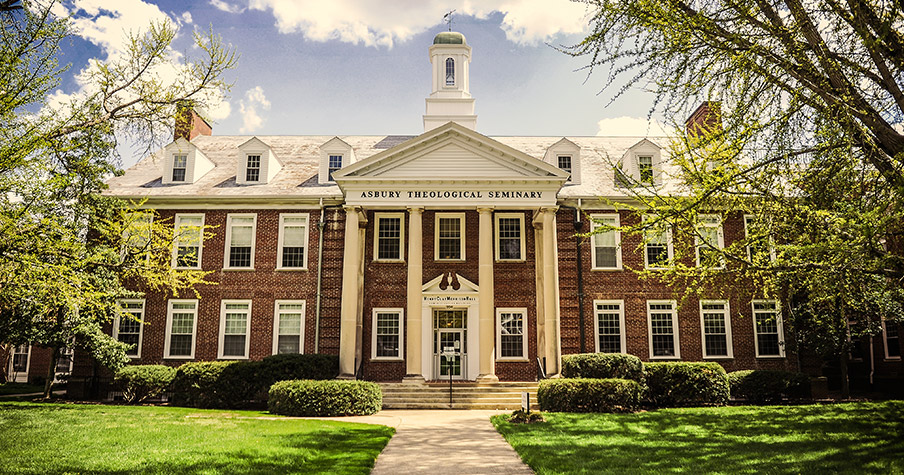
Asbury Theological Seminary, Wilmore, Kentucky. A bold strategy to expand student housing.
It should not be all that surprising that Asbury Theological Seminary, founded in 1923 in the Kentucky Bluegrass town of Wilmore, some 17 miles southwest of Lexington, would be a force for disruptive innovation. Its stately neo-Classical campus –serving more than 1,600 students representing 44 denominations and dozens of countries – belies a tradition of innovation established by its founder, Henry Clay Morrison, and sustained by seven successor presidents and a second campus in Orlando, Florida.
Proclaiming its purpose of “The Whole Bible for the Whole World,” Asbury today has carried its mission of “a community called” into the 21st century by shaping its offerings to meet the evolving needs of prospective and current students. Today, Asbury is fulfilling its mission by expanding enrollment at a time when many theological schools are struggling.
How that came to be is surprisingly counter-cultural: Since 2011, Asbury has been building new residential townhouse-style housing for single and married students on its Wilmore campus. One result has been that Asbury has experienced seven consecutive years of enrollment growth; the school is up by 225 students in the past five years.
“Most schools have moved away from residential education, but we have invested $30 million in new housing,” President Timothy Tennent said. “We’ve had what we call a ‘residential renaissance.’
“There are two reasons we decided to build a whole new generation of married and single student housing. First, it’s integral to Asbury’s historic ethos, which has always emphasized formation in community as part of our training. Second, we noticed that many peer schools were closing or selling their housing units. Therefore, we decided to invest in housing because it would become a distinctive value proposition for us.”
Asbury is one of seven accredited seminaries that, according to the Association of Theological Schools, have generated enrollment growth consecutively over at least the past five years. The schools are Asbury; Midwestern Baptist Theological Seminary in Kansas City, Missouri; Northern Seminary in Lisle, Illinois; Shepherds Theological Seminary in Cary, North Carolina; Sioux Falls Seminary in South Dakota; Southern Baptist Theological Seminary in Louisville, Kentucky; and Wartburg Theological Seminary in Dubuque, Iowa.
While their individual fall 2020 headcount enrollments ranged from less than 300 to more than 3,300, the seven schools together saw total student headcount increase by 43.5 percent over five years. Every school saw the percentage of students go up by at least double digits. Sioux Falls, which has rebuilt itself on competency-based education and created a subscription-based tuition model, saw an increase of 186 percent, going from 172 students in 2015 to 492 last fall. Midwestern’s enrollment nearly doubled from 1,196 students in 2015 to 2,397 last fall.
Most reported record applications for admission during the 2020-21 pandemic with leaders noting that it was a good “transition time” for prospective students to reconsider their vocations and enroll in online courses.
None of these seminaries attracted their students from a “growing” denomination. In fact, five are affiliated with denominations that saw membership declines over the past five years. One is affiliated with a denomination that reports stable membership, and one is independent.
Midwestern and Southern are Southern Baptist, Northern is American Baptist, and Sioux Falls is affiliated with the North American Baptist Conference. (Sioux Falls’ Kairos Project brings in other faith traditions as well.) Although officially nondenominational, Shepherds has independent Baptist roots. Wartburg is affiliated with the Evangelical Lutheran Church in America. Asbury is an independent evangelical seminary in the Wesleyan tradition.
What did they do that enabled the growth? What common characteristics do they have? Interviews with presidents and chief admissions officers explored the reasons for growth.
What they have in common, seminary leaders stressed, is disciplined and focused development of strengths and a “niche,” and not on copying other seminaries. All stressed the importance of serving the church by training pastors and leaders for the local congregations. Beyond that, seven other common characteristics emerged.
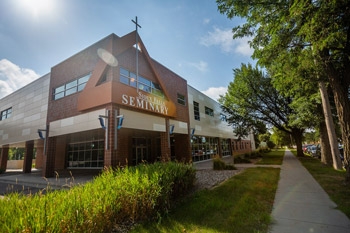
Sioux Falls Seminary, Sioux Falls, South Dakota. Subscription tuition pricing fosters affordability and accessibility.
1) Strong, Engaged President
Each seminary has a president who is engaged in recruiting by speaking at churches and conferences, producing podcasts and radio broadcasts, and writing blogs, books, and articles. Strong presidential leadership includes media visibility that makes the public aware of their seminaries. Albert Mohler, president of Southern Baptist Theological Seminary, has a blog and daily podcast called “The Briefing.” He has written nine books, numerous articles and is frequently quoted in the secular media. “If the president of the institution does not see the recruitment of students as a personal responsibility, the seminary will not flourish,” Mohler said. “From the beginning, I have seen that as one of my primary responsibilities.” Southern’s enrollment has gone up 23 percent over the past five years, increasing by 636 students.
For the last 12 years, Asbury has sponsored “Tennent Tours,” where the president travels around the country to meet with prospective students and donors to see firsthand the ministries of its alumni. “We also started a national conference known as ‘New Room’ as an outgrowth of our Seedbed publishing house,” said Tennent, who also produces a blog and several podcasts. “The conference brings together thousands of pastors and church leaders for renewal and worship.”
William Shiell, president of Northern Seminary, has seen an increase of nearly 60 percent over the past five years to 297 students. He says he spends about 40 weeks a year on the road. He uses this travel for fundraising and recruiting. “What I’ve learned to do is to clear a path in the wilderness so students can come,” he said. “My job is to create lots of different on-ramps and pathways for students to come, and I am always working on that.” Midwestern Baptist Theological Seminary President Jason K. Allen also produces a blog and podcasts. Stephen Davey, president and founder of Shepherds Seminary, produces a 30-minute radio program syndicated daily to more than 300 Christian stations.
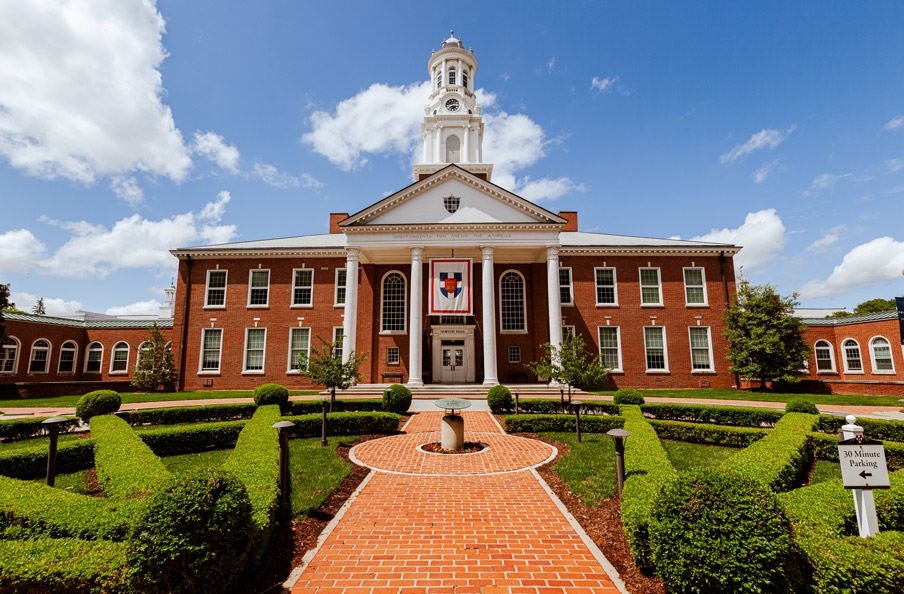
Southern Baptist Theological Seminary, Louisville Kentucky. Intellectually productive faculty are engaged in recruitment.
2) Active, Scholarly Faculty
All the presidents agree that their recruiting and visibility is fruitless unless their seminary has a strong faculty whose work also is accessible to prospective students. Northern Seminary’s Shiell said most of the “strong faculty” are visible with blogs, podcasts, and regular speaking engagements. “We’ve kept a strong commitment to core faculty who are practitioners in their field and who are writing and publishing,” Shiell said. “We still feel students want to learn from an engaged and intellectually productive faculty member rather than from a generic program.” He noted that Northern’s recent market research supported that direction.
Jeremy Pelton, director of admissions at Southern, said the school has “a well-published faculty. We tell students, ‘Come here, and you can actually study with the person who is going to write your textbooks.’”
Kristine Stache, who served as interim president of Wartburg Seminary from January 2020 to February 2021, notes the diverse range of media the faculty use and their commitment to engaging with prospective and continuing students. “Our faculty members are not only out there doing speaking engagements, but they’re also on social media talking about their own work,” Stache said. “When students come for visits, they always meet with faculty, and often come because they formed a relationship with a faculty member who invited them into the community.”
Several schools cited the importance of recruiting faculty for mission, scholarly achievement, and area of discipline, and supporting those who want a more public profile for their intellectual and ministerial capital. Davey, who founded Shepherds Seminary in 2003, said the philosophy was simple: “I believed that if we brought in the most qualified faculty, students would want to come.” That was his own experience. He went to Dallas Theological Seminary not for Dallas, but rather because the late Howard Hendricks was there, and he wanted to learn from the longstanding professor and speaker for Promise Keepers.
“If you have the right faculty, students will tell other students, ‘Hey, this is where you should go,’” Davey said.
Shepherds has seen an increase from a headcount of 75 in 2015 to 134 last fall, an increase of 78.6 percent.
Some seminaries offer financial support to help their faculty achieve visibility and outreach. Allen, president of Midwestern, said the seminary does its best to help faculty and provides resources – including offering graders and reduced teaching loads – to “support their broader writing and speaking ministries that extend beyond Kansas City so that they can project much of what takes place on campus.” Tim Sigler, provost and dean at Shepherds, said the faculty is encouraged to take speaking engagements and those are coordinated with recruiting efforts.
Kevin Armstrong, director of enrollment at Northern Seminary, said a main recruiting strategy is “follow the professors. Our professors have audiences from podcasts, books, and speaking events,” Armstrong said. “We follow them to recruit wherever they’re appearing and teaching.”
What I’ve learned to do is to clear a path in the wilderness so students can come, and I am always working on that.
— William Shiell,
Northern Seminary
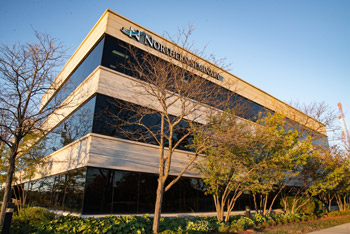
Northern Seminary, Lisle, Illinois. An active president who travels widely to recruit.
3) Innovative Programs
Most of these seminaries offer a fully online master’s program that is popular and accessible. “The M.A. programs really appeal to a lot of people seeking a theological education who are not certain they are called to be pastors and are hoping to have a flexible degree to enable ministry in many different forms,” Southern Baptist Theological Seminary’s Pelton said.
Shepherds created a one-year Master of Theological Studies program that now provides the school with a majority of its M.Div. students. “Once students came in and got their first taste of theological education, they wanted more,” Sigler said. “It was a great way to highlight our faculty and introduce students to what theological education means.”
He adds that Shepherds sends recruiters to visit Christian organizations such as those that reach out to college students, like Cru, InterVarsity, and Navigators. “We ask these students, ‘What would it be like to take one year of your life to prepare for the rest of your life?’” Sigler said. “This approach tends to attract students who may be planning careers in medicine, law, or other professional fields to consider a ‘spiritual gap year.’”
Greg Henson, president of Sioux Falls Seminary and leader of the Kairos Project, which brings together several schools, said that many students are attracted to the school’s programs because they are affordable and accessible. He acknowledges that many students do not plan to become pastors or paid church leaders.
“Our students come from an array of backgrounds,” he said. “We have doctors, real estate agents, fighter pilots, lawyers, and engineers, and we also have missionaries, church planters, and pastors. About half of our students are engaged in some kind of congregational ministry, and the other half are in a vocation outside the congregation. “We had a surgeon who was planning to move into the pastoral ministry, but about halfway through his program, he realized, ‘Hey, this is about me becoming a better surgeon, so I am going to continue being a surgeon.’”
Northern Seminary created a “Doctor of Theological Ministry” program, which requires an M.A. for admission. Most Doctor of Ministry programs require an M.Div. for admission. “We created this because of the demand from a lot of students who had their M.A. degrees,” Shiell said. “As we talked with them, the degree created a pathway for students with a master’s to be admitted into a doctoral cohort along with D.Min. students.”
Midwestern developed its “Timothy Track” for first-year residential students in the M.Div., an immersive mentoring program designed to help novice seminarians discern and shape their vocation. Students get a 50 percent scholarship in the program along with credit for a local-church practicum, and they receive one-to-one mentoring from local pastors, said Camden Pulliam, vice president for enrollment management. “The students get experience in the local church, financial help, and a mentor to help them think through their calling,” Pulliam said. “Our hope is that after the first year the practicum turns into a staff position or other paid leadership role.”
Growing Seminaries Change in headcount enrollment, 2015-2020.

Data source: Association of Theological Schools

Midwestern Baptist Theological Seminary, Kansas City, Missouri. Mentoring programs that foster student discernment.
4) Emphasis on Spiritual Growth and Discipleship
Some growing seminaries have created programs that combine spiritual growth and discipleship with their academic studies. Administrators at Shepherds and Sioux Falls both said they recognize that some of their entering students are more interested in growing spiritually and discerning their vocation than they are in becoming ordained pastors.
Shepherds requires a one-year “Heart Study” program for all first-year students and spouses. They have weekly meetings. “Students begin the year together sharing their detailed testimony with the group, then work each week with devotional materials addressing issues such as addictions, purity, anxiety, and love for one another,” Sigler said. “We are committed to helping men and women who not only know God’s Word but also live out a response to that knowledge.”
Similarly, Sioux Falls Seminary has the Kairos Project, a network spanning six continents, four languages, and five partner institutions. Chad Smith, an enrollment advisor at Sioux Falls, said each first-year student is assigned a faculty mentor, a vocational mentor, and a personal mentor “each of whom pays close attention to their students’ holistic, integrative development throughout their progress in the individual degree programs.”
Henson added: “We think of theological education as first and foremost a journey of discipleship that happens to result in a degree. We created a structure through which students can earn high-quality degrees, but we centered it as a formational and transformative journey in discipleship.”
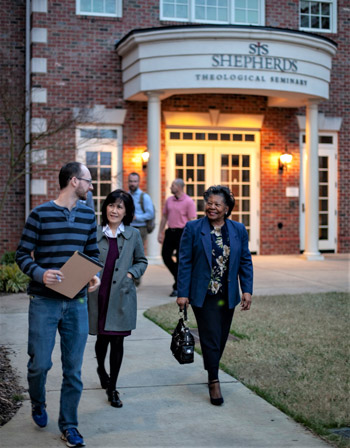
Shepherds Theological Seminary, Cary, North Carolina. Adherence to the inerrancy and sufficiency of Scripture.
5) Professional Admissions Strategies
Borrowing from other higher education institutions, admissions officers at these schools have created a wide variety of techniques to reach out to prospective students. Jackie Baumhover, director for admissions at Wartburg, said the school uses customer management software to help. The headcount has grown from 147 in 2015 to 236 last fall, a 60.5 percent increase.
“I’m kind of a nerd when it comes to things like statistics and data analytics,” Baumhover said. “The more information I can pull out of our database system, the better. I make sure I am tracking how and when I had a conversation with someone. I know whom I should be talking to and when. I get reminders two or three weeks after I talk with someone to check in and say, ‘Hi, how are you? What’s going on?’ So, I rely on apps, calendar-invites, social media, email, database work.”
Stache said that Baumhover focuses not only on the technology but also on developing relationships with prospective students. “She is accompanying them on their journey to discernment and helping them with their questions about what Wartburg has to offer to help with their formation,” Stache said. “She really is their companion, if you will, on that journey. And I think that helps students in the process of deciding where to go and what program best fits their needs.”
Smith at Sioux Falls also develops relationships with prospective students. “Part of my role is fielding inquiries and working with prospective students,” Smith said. “Seven out of 10 times, it’s a phone call saying, ‘I am interested in learning more about who I am and who God has called me to be’ as opposed to, ‘Hey, I’m interested in getting licensed or ordained.’”
Henson said the head of a local hospital’s human resources department enrolled at Sioux Falls to further her education. “She told six or seven of her employees about it, and three of them had submitted an application within a week,” Henson said. “We have helped them see that theological education is for every follower of Jesus, and they are soaking it up like a sponge. It’s been very exciting.”
The coronavirus pandemic also prompted some of these schools to creatively seize virtual opportunities to reach students. Northern Seminary, for example, created a virtual “Taste of Northern” day, said Kevin Armstrong, the director of enrollment. “We invite people to sit in on as many classes as they want for one day and feel welcome to participate,” Armstrong said. “We want to give people a door into the personality of our seminary.”
Mohler, Southern’s president, participates in live Zoom conferences with groups of prospective students and answers their questions. And Midwestern created an “Ask the Experts” link on the seminary’s website, a weekly live call-in show for prospective students featuring professors speaking out of their expertise. Many schools use giveaways to attract prospective students and connect with them by giving away faculty books.
6) Doctrinal foundations
Some leaders believe their seminary’s strong doctrinal foundations are a key to their growth. “The conservative theological convictions of this school have almost everything to do with the fact that the young people coming to study here want to come to a school that teaches these truths,” Mohler said. Kevin Bish, Asbury’s associate provost and vice president for enrollment management, noted Asbury’s “long commitment to historic Christianity” as a draw. “We want to message out that we’re not wavering on that,” Bish said. “We haven’t waffled or had any challenges to who we are or what we represent.”
Davey said one of the draws to Shepherds is “our focus on the inerrancy and sufficiency of Scripture.” “We appeal to a conservative, evangelical constituency,” Davey said, “and they appreciate that we are focusing on these issues of Bible and theology.”
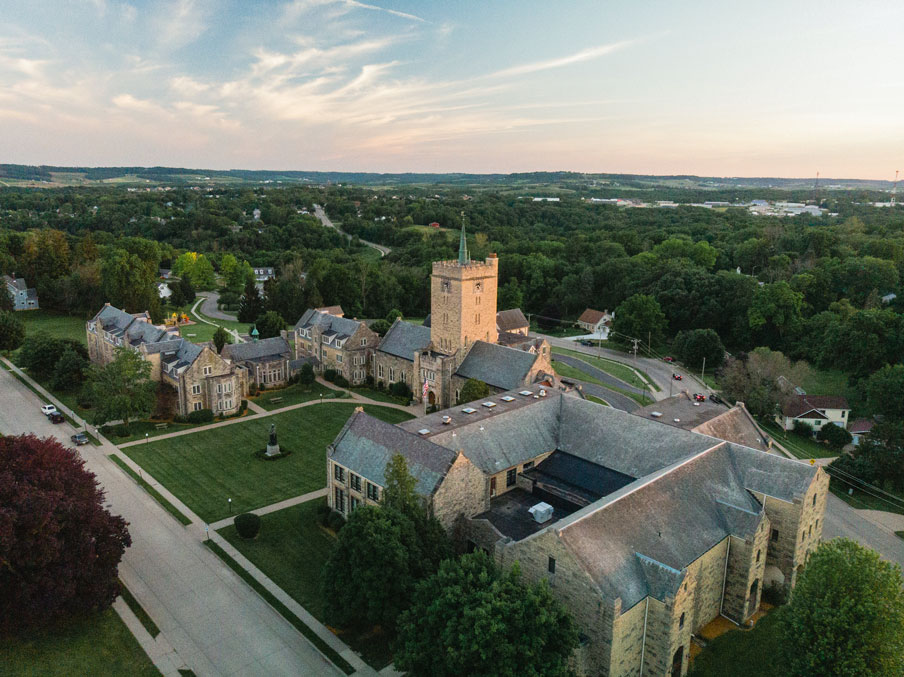
Wartburg Theological Seminary, Dubuque, Iowa. Professionalized and personalized admission strategies.
7) Affordability
Some seminaries have reduced tuition rates and the number of hours required for certain degrees, like the Master of Divinity, to make them more affordable. At these schools, per-credit-hour tuition ranges from $285 to $775. Sioux Falls restructured administrative costs, enabling a substantial reduction in its tuition, and it quit charging per class or per credit hour. “We charge a monthly subscription price of $300,” Henson said. “Students are allowed to start and stop any month of the year.”
The two Southern Baptist seminaries have reduced tuition by about 15 percent for Southern Baptist students. And Midwestern offers a 50 percent scholarship to all residential students who enroll in its “Timothy Track” mentoring program.
Everyone agreed that there is no one “silver bullet” to make a seminary grow. It has to result from a team effort involving the trustees, president, administrators, and support staff. Sioux Falls’ Henson sums it up this way: “If there’s anything we’ve done that has helped our growth, it is making theological education affordable, accessible and relevant while remaining faithful to Jesus Christ. You can apply those practices to any school.”
Editor's note: The print edition of this story incorrectly identified Asbury Theological Seminary as being "officially United Methodist." Since its founding in 1923, the seminary has been independent. The story has been updated to reflect that.